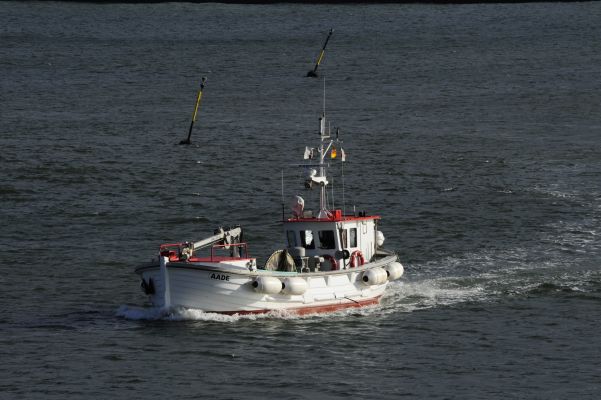- Created by Angelika Dummermuth, last modified on Mar 07, 2023
The Biologische Anstalt Helgoland has a long tradition in the generation, archival and analysis of marine, ecological time series. The first temperature and salinity time series were started in 1873. The earliest macroalgal data were also collected in the 19th century. In 1962 one of the most important time series, the so-called Helgoland Roads time series on plankton was initiated. In the context of that monitoring programme, phytoplankton data are quantitatively analysed every working day. Therefore this time series represents one of the temporally most highly resolved time series in Europe. Since 1974 additional data on zooplankton have also been collected and are now being analysed thrice weekly. In addition to these core time series, bacterial counts have also been carried for over 40 years, although this time series has now been discontinued.
The measuring point of the Helgoland Reede time series (54°11'N 7°54'E) is located in the German Bight, about 60 km from the mainland. The measuring point is located between the main island Helgoland and the small neighboring island Düne. The water depth varies depending on the tide and is up to 10 m. Extensive monitoring of the pelagic (surface) was started here in 1962. The conditions measured there characterize the transition zone between coastal waters and the open North Sea. The annual variation of salinity at the Helgoland Reede is influenced by the annual dynamics of the mainland outflows, especially the Elbe. Variations in the current patterns of the German Bight control the influence of the coastal water and thus the local conditions, which are recorded by the measurements at the Helgoland Reede.
The time series is characterized by the length of the observation period in combination with a high temporal resolution (up to 5 samples per week) and a high level of detail. The number of parameters measured includes water temperature, salinity, nutrients, Secchi depth, zooplankton and phytoplankton. The phytoplankton time series, for example, represents one of the most comprehensive marine data sets ever, with approximately 230 different species.
The different time series represent an essential database for the analysis and modeling of the influence of climatic and anthropogenic changes on the marine ecosystem. They are the subject of research on food web relationships and the seasonal dynamics of various ecological processes, e.g. the spring bloom of phytoplankton.

Publications:
Helgoland Roads Phytoplankton (link to webpage)
The Biological Station Helgoland holds one of the largest and longest marine plankton time series in Europe, named 'Helgoland Roads' after the sampling location. This time series has been running continuously, with samples taken on a work-daily basis since 1962. As far as possible species counts are carried out at species level. This has allowed us to show long-term changes in abundance and seasonality of different organisms, but also to reliably demonstrate the appearance of species entirely new in the Helgoland Roads phytoplankton community. More complex analyses have also shown long-term shifts in diversity and delays in the start of the spring bloom after warm autumn/winter seasons. The latter was shown using a simple index: The mean diatom day.
All Helgoland Roads data are archived in the online repository PANGAEA. For our biodiversity data representative image material (as meta data for the numerical data sets) is also archived in the planktonnet database.

Publication Helgoland Phytoplankton: Wiltshire, K. H., A. Kraberg, I. Bartsch, M. Boersma, H. D. Franke, J. Freund, C. Gebühr, G. Gerdts, K. Stockmann, and A. Wichels. 2010. Helgoland Roads: 45 years of change in the North Sea. Estuaries and Coasts DOI 10.1007/s12237-009-9228-y
Helgoand Roads Zooplankton (link to webpage)
The Helgoland Roads time series was started in 1974 by Wulf Greve, initially at the Biologische Anstalt Helgoland institute and later continued in cooperation with the German Centre for Marine Biodiversity and the Federal Maritime and Hydrographic Agency. It is now managed by the Biological Station Helgoland again.
Every Monday, Wednesday, and Friday two oblique plankton net samples (150 μm, 500 μm) are collected from the monitoring site (54° 11' 18" N, 7° 54' E). From each sample, almost 400 taxonomic entities of holoplankton and meroplankton (e.g., benthic and fish larvae) are identified and counted for abundance.
The purpose of the Helgoland Roads programme is to monitor and document high frequency plankton population dynamics to detect and investigate community dynamics at seasonal and longer time scales and to better understand long-term changes in biodiversity.

Publication Helgoland zooplankton: Boersma, M., K. H. Wiltshire, S.-M. Kong, W. Greve, and J. Renz. 2015. Long-term change in the copepod community in the southern German Bight. Journal of Sea Research 101:41-50.

Helgoland Transects
In addition to the Helgoland Roads Core time series station we also operate monthly transect cruises in the German Bight. At each transect station salinity, temperature, nutrients and chlorophyll are measured. Phytoplankton data for some stations and years are also available. These provide important contextual information to compare with the Helgoland Roads station and facilitate an assessment of the Helgoland Roads data in a larger biogeographical context.

- No labels